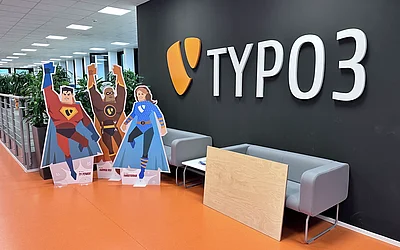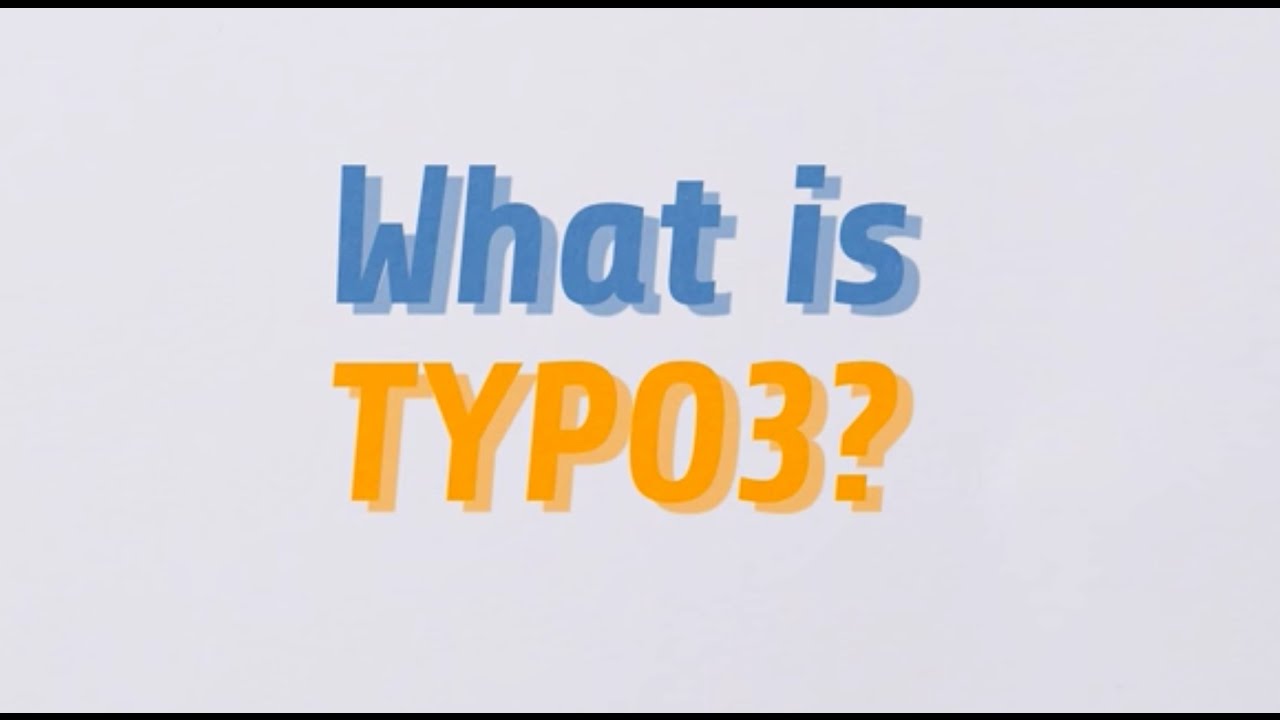
This is Typo3
TYPO3 is an online editing system with which dynamic websites can be realized. The open source software is primarily used to create and maintain websites for companies and public institutions. In 2002, the third version of the content management system was made available to the general public for the first time - and a success story began. To this day, the "3" is appended to the name, as this version marked the final breakthrough of the application. "TYPO" was chosen as the name because the developer Kasper Skärhoj lost part of his work during the development process due to a typo. Most of the almost 5,000 published extensions are made available free of charge by the respective developers. This incredible achievement of the community results in almost endless customization possibilities for working with TYPO3.

What does CMS Typo3 mean?
You have to look back a little! The first websites were pure HTML. This means that the text was static and could only be changed at great expense. Content Management System is now the functionality that treats the content separately from the layout of the website. This has several advantages! On the one hand, you as a customer have the advantage that you can maintain content and photos yourself. On the other hand, if you want to change the layout at some point, the content usually remains the same and we develop a new layout in the background. And TYPO3 is a top-class CMS! It offers a wide range of functions that are already integrated into the system. But there are also a lot of extensions, which makes the system very flexible in its application and therefore adaptable from start-ups to large corporations.
You can find an overview of the most important functions here.
Especially when systems are maintained by different editors, they reach their limits.
With TYPO3's versatile user administration and workflow management, teams can work optionally without consuming the planning of large projects or creating conflicts during coordination.
Communication between editors and administrators takes place via integrated task and message management. This allows editors who are physically separated to coordinate and exchange information on the progress of certain tasks. The client is automatically notified once certain milestones have been completed and informed about the further progress and outstanding tasks.
Different areas of the backend and frontend can be released for user groups. This ensures that special settings can only be made by qualified persons. Visitors can authenticate themselves on a website via a freely definable login form and thus gain access to protected content.
Of course, corresponding restrictions are also taken into account when searching websites. For example, only logged-in users receive search hits within protected page areas. Authenticate sensitive content on a website and thus gain access to protected content. Download areas or forums can thus be protected against unauthorized access and made available to selected visitors.
By integrating existing directory structures using the Lightweight Directory Access Protocol (LDAP), user data from existing services such as the Windows Active Directory (AD) can be transferred to TYPO3. The rights are automatically transferred to the corresponding TYPO3 project and regulate the users' editorial options. Authentication at the backend can also be carried out with the help of LDAP.
Security is a top priority for TYPO3 developers
That is why there is a dedicated TYPO3 Security Team, which deals with the security-relevant aspects of TYPO3. Regularly published security reports on the basic system and its extensions provide information on current security vulnerabilities. In these reports, users can read about the specific security problem, how critical it is and whether a solution already exists.
A committed community makes a significant contribution to ensuring that security gaps and bugs are found and rectified quickly. Every user can thus contribute to the security of TYPO3.
Numerous security functions also enhance day-to-day work with TYPO3. For example, access to the TYPO3 backend can be restricted to a specific IP address range in order to allow access only to employees of your own company. The administrator can also be notified of suspicious system events by e-mail. For example, the administrator is informed immediately in the event of incorrect login attempts to the TYPO3 backend.
TYPO3 encrypts the transmission and storage of passwords. With the help of an SSL certificate, the entire data transfer between server and browser can also be carried out securely, for example to protect the transmission of personal data.
And not only with Typo3 but also with us, security is written in capital letters! That's why we recommend our maintenance service package at this point. You certainly know the updates for Windows 10! Or with your smartphone! The same applies to TYPO3.
TYPO3 has taken accessibility into account since 2005!
The Accessible Information Technology Ordinance, which supplements the Disability Discrimination Act, has been in force since 2005. This ordinance is mandatory for websites and all publicly accessible intranet offerings of federal administration authorities.
15% of the EU population currently suffers from physical limitations. In addition to the respective health problems, the lack of social connection also plays a major role in the lives of many disabled people.
Accessible or low-barrier websites remove obstacles on the Internet and thus simplify the use of information technology. The associated facilitation should therefore be a high priority for both private and commercial websites.
Clearly structured texts can be reproduced in the logically correct order with the help of a Braille display or a screen reader. Visually impaired people can also use alternative descriptive texts to understand the content of embedded images.
TYPO3's WYSIWYG editor generates valid HTML code by default, which forms the basis of accessible websites.
Expandability
The standard installation of TYPO3 is equipped with all the important functions that a content management system must have. TYPO3 therefore offers the required range of functions for a large number of websites right from the start. In addition, the modular structure makes TYPO3 an extremely flexible system for almost all areas of application.
In addition to the extensive standard features, it is the countless extension options in particular that give TYPO3 its almost limitless flexibility. As already mentioned, there are currently almost 5,000 extensions from various thematic areas. These extensions are stored in the TYPO3 Extension Repository (TER), a central directory for TYPO3 extensions, and can be easily integrated into a TYPO3 installation via the extension manager. Every developer can also upload their own extensions to the TER, which are then available to the entire TYPO3 community free of charge.
The most popular and high-quality extensions, which usefully supplement the functional scope of TYPO3, are permanently integrated into the basic system after intensive testing by the TYPO3 development team. One example of this is the index search, which is now available as standard and was available as an optional extension up to version 3.8. With its help, TYPO3 pages and integrated documents can be easily searched.
Quality and structure are not only relevant for search engine optimization
Above all, they are a guarantee for returning visitors to your website. For this reason, it is particularly important to be able to enter and edit new content such as text or images easily and promptly.
Writing editorial content or editing existing texts is therefore child's play with TYPO3. Even less experienced users can quickly learn how to use the editorial tools. Workflows are similar to those of familiar Office programs such as Microsoft Word.
Thanks to the Rich Text Editor (RTE HTML Area), which is already available in the standard version of TYPO3, texts appear during editing exactly as they will later be displayed on the website. This makes it very easy to create articles. Texts can be formatted or supplemented with additional elements such as images or links according to taste. The editor is completely configurable. Superfluous buttons can be easily removed. It is also possible to add your own functions.
Numerous wizards support editors when creating new pages and content. Step-by-step instructions are available for a large number of complex content elements, such as forms or tables, which guide the user through the various menus.
Editors can use front-end editing to edit the content of a website even faster. As the name suggests, you can use this function to edit the individual elements of your website directly in the frontend. In this way, even editors with no TYPO3 experience can concentrate on their editorial work. Extensive backend knowledge is required.
If you want to assert yourself as an entrepreneur on the global market today, you have to rely on multilingualism!
This means not only that employees should have good foreign language skills, but above all that websites should be multilingual.
TYPO3 has been an international and therefore multilingual project right from the start. The developers therefore ensured very early on that the system was highly adaptable in this respect. The TYPO3 backend has now been translated into 50 languages. This achievement, like many others, could only be achieved with the help of the large community.
Frequently used extensions are also already available in many language versions. The basic versions of all extensions are also developed in English. Also structured according to a clearly defined standard. This enables international users to quickly get to grips with the functionality as well as an uncomplicated translation into the respective language.
In the current versions of TYPO3, the character encoding UTF-8 is preset by default. With this encoding, all characters from all languages in the world can be displayed. Even extensive languages from the Asian and Arabic regions can be managed with TYPO3 in this way.
Users of the content management system define a standard language when creating a website. Additional translations can be entered in the page tree alongside editorial content in this language. It is therefore not necessary to create several page trees in different languages. The advantage: If no translations are available for certain content, the original content in the default language is displayed.
The use of Typo3 saves you time-consuming image editing when creating your website!
TYPO3 automatically adjusts the pixel and file size of photos and graphics and saves them in a web-optimized format. Images are reduced in size with just one mouse click using a complex, server-side process and deliver high-quality image material that can be used immediately for editorial work.
A click enlargement function for images is already integrated as standard in TYPO3. With the easy-to-install Perfect Lightbox extension, photos and graphics can also be highlighted in a modern and effective way.
In TYPO3, custom graphics, e.g. for the header of a website, can be dynamically combined from existing image material and any fonts. In addition, various effects such as drop shadows or transparencies can be created. In this way, users can, for example, adapt a title graphic to the thematic orientation of a page without having to create a new graphic for this page area. This task is performed automatically by the content management system.
Editorial changes to the structure of the page tree are displayed simultaneously in the website menu. Menu items added by the editor are displayed in the appropriate place immediately after saving. With just a few lines of TYPOScript, changes to the menu design can also be easily implemented.
TYPO3's graphical functions can also be put to good use when creating your own extensions. Image database systems realized with TYPO3, for example, automatically convert uploaded image data into any target format such as JPG, GIF or PNG. The source format can be a TIFF, EPS or PDF document in addition to conventional image formats.
Individuality is the be-all and end-all
Above all in the area of corporate identity. Nowadays, a company's Internet presence is its business card. First impressions are gained here and the decision for a possible collaboration may already be made when looking at the online presence. The wide range of different service providers on offer does not make the choice easy for those looking. That is why it is important for a company to stand out from the crowd with its presentation on the World Wide Web.
TYPO3 is ideal for such a project, because its expandability means that the possibilities for visual customization are almost unlimited. Existing HTML layouts can be integrated into TYPO3 projects without any problems. Based on a given HTML template, the administrator can define any number of areas into which various content elements can later be inserted.
The content management system provides developers with the system's own TYPOScript configuration language for the logical description of websites. Created TYPOScript templates are interpreted by the system and implemented for display in the web browser. Instead of having to redefine the design of each individual page, a central TYPOScript template can be used to define the appearance of an entire project.
By using the Mask extension, you can also define your own types of content elements, so-called "flexible content elements". This option opens up further individual design options for users.
Backend
JDepending on the editor's authorization, it provides access to all administrative areas that are necessary for organizing the website structure, managing editorial content and expanding the TYPO3 installation.
The division into the areas of module list, page tree and work area ensures clarity and makes it much easier to use the content management system, while the organization of the backend from left to right is reminiscent of Windows Explorer, for example, and is therefore very clear even for newcomers. Individual setting options for different editors or user groups also make it easier to manage access rights and areas of responsibility.
The structure of the website is represented by the page tree - so users always have an overview of the structure of their projects. Several page trees can also be maintained in parallel in TYPO3. This is very practical, for example, if a company wants to operate several separate Internet presences - e.g. a company website, an online store and a forum - in just one Typo3 installation.
The TYPO3 user interface can be used with any modern web browser and can be functionally expanded with additional extensions. Thanks to the intuitive navigation, users can quickly find their way around the backend.
Uploading, renaming, copying, moving and deleting files as well as editing HTML or CSS templates is possible with the file manager integrated in TYPO3. An image preview is also available for easy management of graphic content.
Forum
For many years, the mm-forum extension has proven itself for the simple administration of forums. Even larger forums with several hundred thousand posts can be easily managed with mm-forum. An integrated overview provides forum operators with statistics on registered users and topics. Detailed user profiles can also be created. An integrated private messaging system makes it easy for forum members to communicate with each other.
Our consultants and partners are always available for a free consultation.
Even if you already have a Typo3 website and want to update it. We would like to take this opportunity to invite you to take advantage of our maintenance package. This includes a system check as well as updates and upgrades for a period of one year.
For more information about Typo3 and an individual offer for your needs, please contact us.
Calendar for events or other announcements
The practical calendar extension can be used to display yearly, monthly, weekly, list and event views. The customization options are manifold. Various categories can be defined to guarantee optimum clarity. However, the function of being able to create several calendars (e.g. internal appointments) is particularly interesting. These can also be restricted to certain user groups. Authorized front-end users can enter appointments directly into the calendars.
Our consultants and partners are always available for a free consultation.
Even if you already have a Typo3 website and want to update it. We would like to take this opportunity to invite you to take advantage of our maintenance package. This includes a system check as well as updates and upgrades for a period of one year.
For more information about Typo3 and an individual offer for your needs, please contact us.
News
This widely used extension enables simple news management in the TYPO3 backend. The creation of news categories including images, as well as the integration of additional documents, is easily possible with News. List, archive and individual views are freely configurable and can be adapted to your requirements. The extension also offers a freely configurable archiving function and RSS export options.
Our consultants and partners are always available for a free consultation.
Even if you already have a Typo3 website and want to update it. We would like to take this opportunity to invite you to take advantage of our maintenance package. This includes a system check as well as updates and upgrades for a period of one year.
For more information about Typo3 and an individual offer for your needs, please contact us.
What is a multisite CMS and how can it help your company?
Multisite CMS: Erste Schritte

Are you looking for an efficient and cost-effective way to manage multiple websites? With a multisite CMS, you can run multiple websites from one location, increase control over your content and improve search engine optimization. Companies operating multisite environments need to share content across all their platforms securely and easily. For such companies, integrating content is a complex undertaking. The best multisite CMS providers offer a solution to these problems, with centralized site management and branded content sharing capabilities across all your sites.
Multisite Content Management mit TYPO3 CMS
![[Translate to US:] Multi Site CMS [Translate to US:] Multi Site CMS](https://www.typo3-solutions.org/fileadmin/_processed_/f/d/csm_Multisite_CMS-2_8bffc781b2.webp)
Gain control over your content and create brand consistency
Building a consistent brand requires control over all your digital assets and content. But managing assets across multiple properties can be complex and difficult. Cleaning up and updating your most important assets centrally prevents the use of outdated, unbranded designs that run counter to your identity.
TYPO3 CMS is built around the page tree, a view that makes it easy to control your content and build a consistent brand:
- Reuse any content, from a snippet to a whole group of pages, in any website in your installation. Update it once and it will be updated everywhere you use it on one of your websites.
The page structure offers finely graduated access control that can be applied to all branding elements such as styling, images and media. You retain control over the appearance of your brands and enable Manage user access to give local teams control over translated content (e.g. for a specific branch of the page tree) while reserving access to global content for the relevant teams.
Relieve marketing and save resources
By consolidating your websites under one multisite CMS, you can streamline your digital communications and online business. TYPO3 frees you from the need to duplicate assets, switch between marketing software systems and interact with IT departments to get your work done. You and your team can focus on driving traffic to your business.
TYPO3 provides editors with tools that support them in their daily work - with simple interfaces for planning, writing, editing, previewing and monitoring content. Functions such as TYPO3's digital asset management system (DAM) ensure effective search, access and reuse of content and significantly reduce the effort required for editing and administration.
TYPO3 also integrates with other leading DAMs (such as CELUM) to store, classify and manage images, videos and brand identity assets, allowing you to increase the quality of your digital assets by adding rich metadata.
Multisite Content Management mit TYPO3 CMS
Deploying a multisite CMS can be tricky, and you have a lot to plan and keep track of - including content maintenance and reuse, user access rights, marketing campaigns and integrations. Fortunately, with TYPO3, you get world-class open source enterprise content management that supports multisite installations from the start.
Once set up, TYPO3's workflows and content creation tools help you create engaging online experiences that are optimized for modern platforms and integrate seamlessly with third-party applications and services.
A multisite CMS can help you build your brand and strengthen your team. Start your multisite CMS journey with TYPO3.
